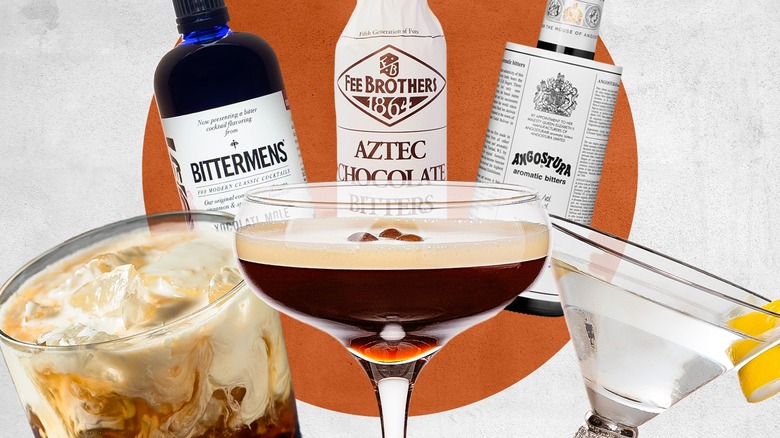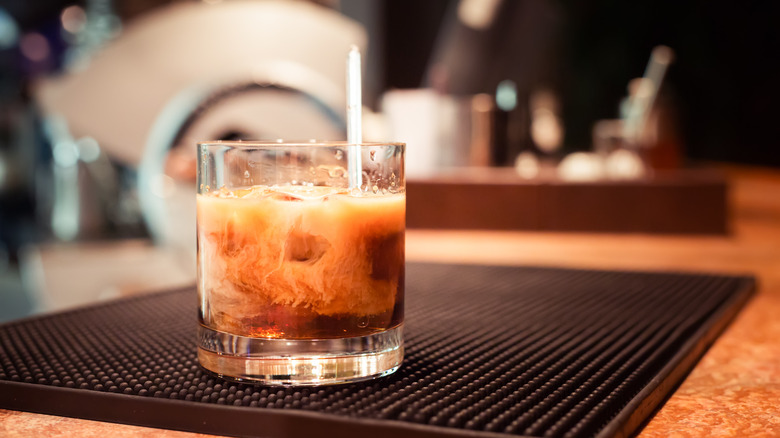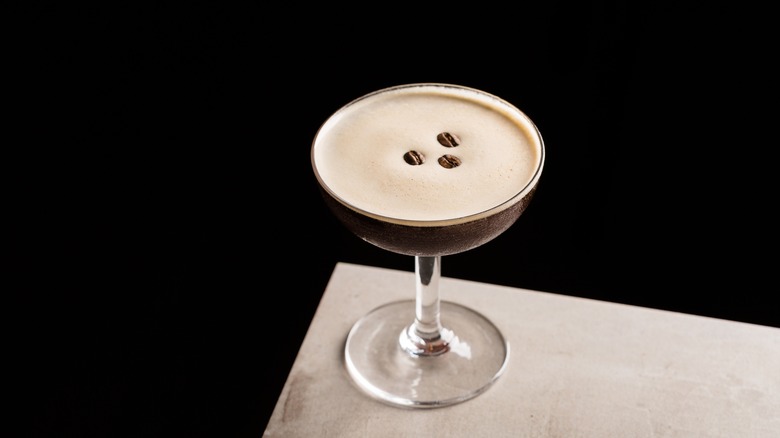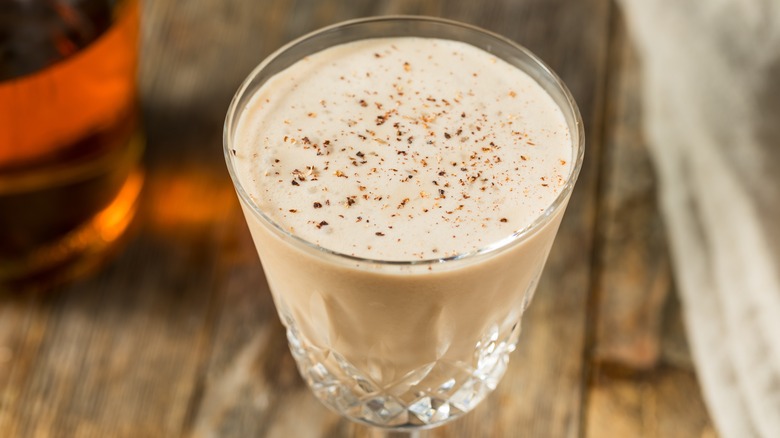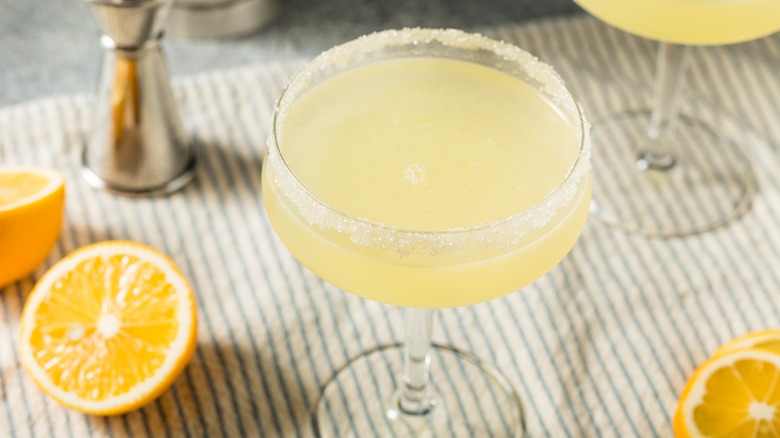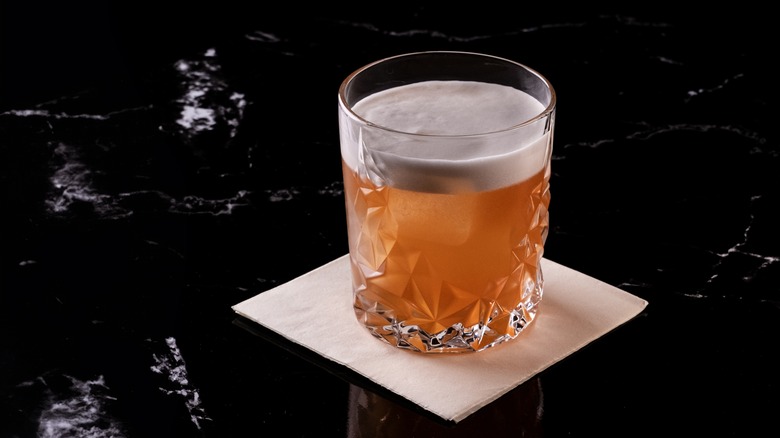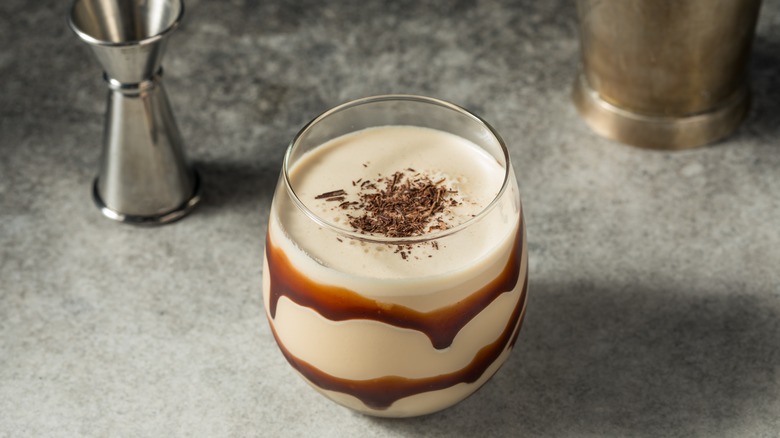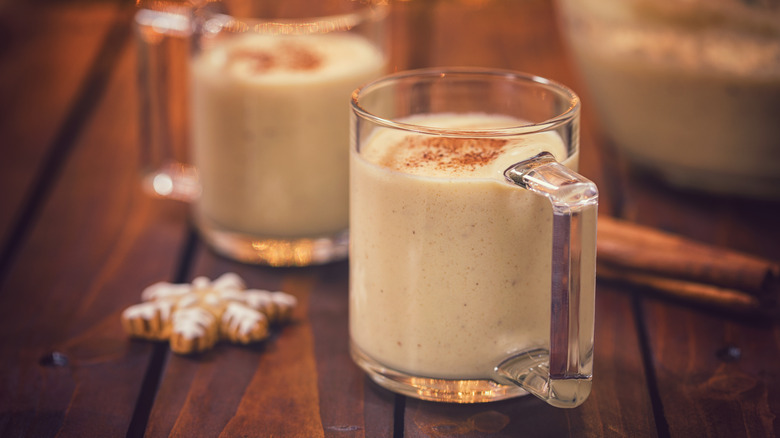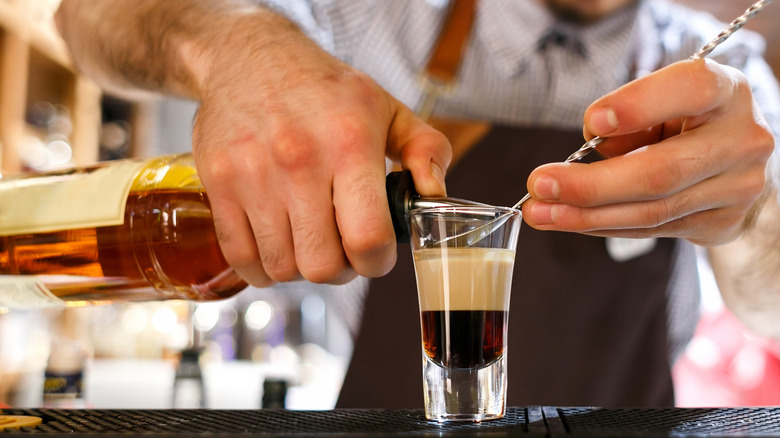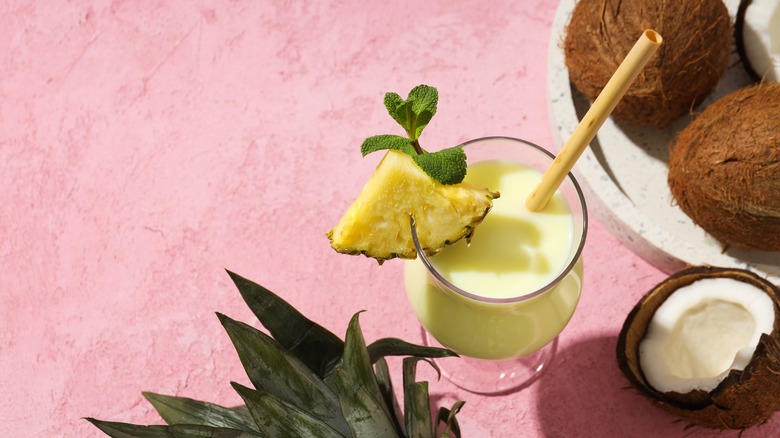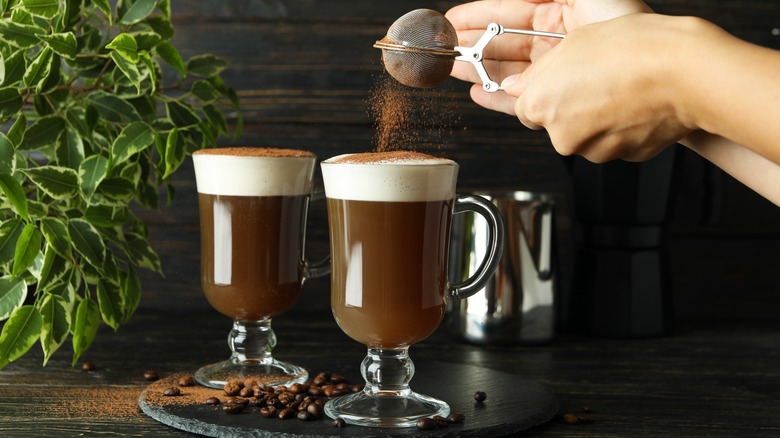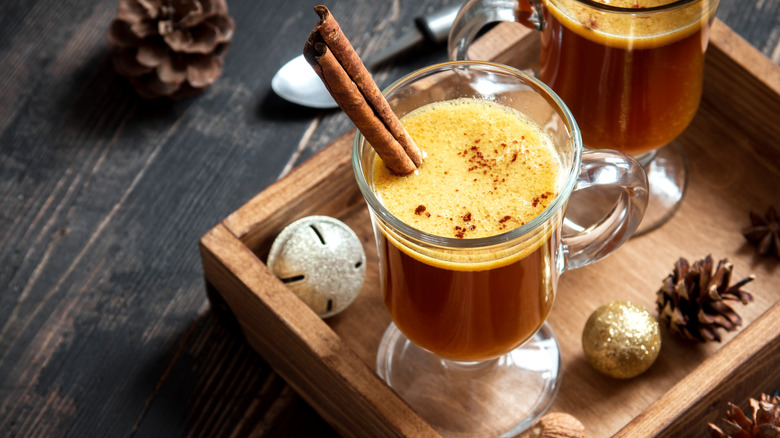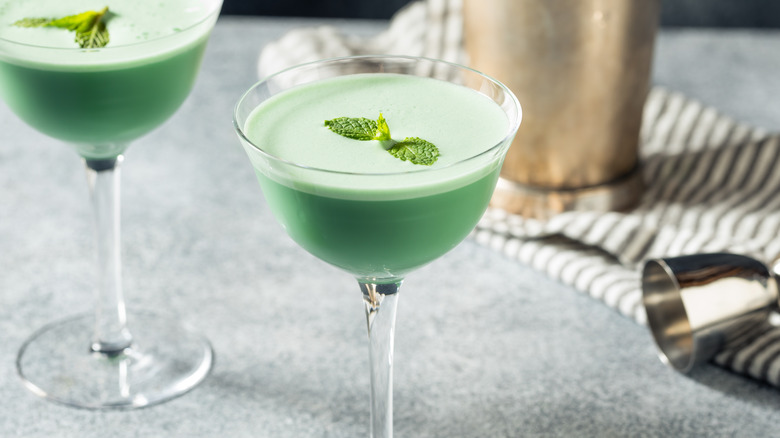12 Dessert Cocktails That Are Better With Bitters, According To A Bartender
The beauty of cocktails is that there are styles for every occasion. Some are meant to whet the appetite before a meal, while others are best when paired with food. We also have the world of dessert cocktails — after-dinner concoctions that can complement a sweet course, or take its place altogether.
During my career as a bartender, there was something that surprised me about dessert cocktails. Regardless of whether they're complex and creamy or simple and refreshing, it's uncommon to find an original recipe that includes bitters. Bitters are essentially infused alcoholic tinctures, available in a massive variety of styles. Like seasonings, a few dashes can be all it takes to elevate the taste of a cocktail, either by introducing unique new flavors or helping the existing elements work together more effectively.
As a result of my befuddlement, I've frequently experimented with bitters in dessert cocktails, and found some products that genuinely elevate them. Although you might not find these bitters in every bar, they all come from reputable producers in the bartending world and are names that I've featured before in a list of ranked cocktail bitters brands. There's a good chance that you've previously encountered — and possibly made — some of the dessert cocktails listed below. Next time, I suggest you try adding a few drops of these recommended bitters to give the drinks a truly gourmet overhaul.
White Russian
White Russians are one of my all-time favorite after-dinner drinks. There's a special place in my heart for iconic cocktails that stick to a short and simple recipe yet manage to become so much more than the sum of their parts.
Consisting solely of fresh cream, Kahlúa coffee liqueur, and vodka, the white Russian is luxuriously smooth and decadent. I'd argue that no-nonsense cocktails like white Russians don't necessarily benefit from heavy tweaking of the base ingredients, but this is where bitters are perfect. For starters, I like to add a few dashes of my go-to cocoa bitters, Bittermens Xocolatl Mole. Cocoa bitters are more versatile than you might think, boasting a rich, bitter-chocolate profile with dark spice notes. These cocoa bitters were the first to hit the bartending scene, and they complement the coffee and cream thanks to their savory flavor profile inspired by Mexican mole sauce.
I'm also a big proponent of combinations of bitters to upgrade cocktails. For my white Russians, I also like to add a few dashes of Angostura Orange Bitters. I'm a big fan of orange-flavored chocolate, and this tincture helps boost the cocktail's dessert-like qualities. While there are more intensely flavored orange bitters available, in this case, less is more — and Angostura's version has a nice spiciness that enriches the cocoa flavors.
Espresso martini
Most bartenders have something of a love-hate relationship with espresso martinis. Being asked to make large rounds of them at once can be a huge headache, and if there's one thing worse than intoxicated clientele, it's highly caffeinated intoxicated clientele. But, credit where credit's due, the espresso martini earned its place as a modern icon in the cocktail world, and it's a superb dessert cocktail.
If I'm making this drink as an after-meal treat, I tend to play with the recipe to create a richer espresso martini with chocolate syrup or with high-quality Irish cream liqueurs. I'm also fond of eschewing vodka in favor of using rum in espresso martinis. However, whichever recipe I end up choosing, I always reach for the cocoa bitters.
There's a fair amount of diversity among cocoa bitters, and for espresso martinis, I like Fee Brothers Aztec Chocolate Bitters. These are slightly sweeter than other cocoa bitters on the market, with a subtle touch of caramel that helps to counter the bitterness of the fresh espresso. This variety also has a slightly peppery aspect, which makes the cocoa stand out more and contrasts with the soft mouthfeel. Furthermore, the Aztec Chocolate Bitters have pronounced cinnamon notes that contribute to the dessert-like qualities of the cocktail.
Brandy Alexander
Whenever I've created a cocktail menu for a restaurant, brandy Alexanders — in their classic form, or with a hedonistic twist — almost always make my list. The harmony of fresh cream, sweet-yet-spicy Cognac, and chocolaty crème de cacao make it a nearly unbeatable dessert cocktail.
However, whether I'm sprucing up the recipe or sticking to the basics, the brandy Alexander is another drink that I'll always add bitters to. I've experimented with many of such tinctures over the years, including most varieties of chocolate bitters, but I've found the most effective to be the Barrel Aged Vanilla from El Guapo. With a penchant for creating quirky bitters — with unusual flavors like Gumbo and Crawfish Boil — El Guapo is bound to concoct a vanilla product that isn't your run-of-the-mill variety.
El Guapo procures wild-pollinated vanilla beans from Zanzibar, and then ages the bitters in casks that once held Roulaison rum. For starters, the premium vanilla dramatically enhances the cream component of the brandy Alexander, giving it a kind of crème anglaise flavor. The rum barrel character also provides a woody, fruity aspect, with a touch of sweetness that highlights Cognac's unique qualities. I might still add dry cocoa bitters if I use sweet modifiers like salted caramel syrup, but for the classic recipe, El Guapo's bitters are more than enough.
Lemon drop martini
Inspired by candy, the lemon drop martini was invented in San Francisco in the 1970s, and ever since then it's remained one of the most popular palate-cleansing cocktails around. Few other drinks manage to showcase the brightness of lemon in such a refreshing way. Plus, the lemon drop martini's easy recipe — calling for vodka, triple sec, lemon juice, and simple syrup — makes it the perfect crowd-pleaser when you're hosting dinner guests at home.
Lemon bitters are the clear choice for this cocktail, and I usually stick with The Bitter Truth's version. These were supposedly the first commercially available lemon bitters, but that's not what sets them apart. Obviously, these bitters enhance the lemon flavor of the cocktail, but they also have a spiced-honey aspect that thickens the taste profile. Most importantly, The Bitter Truth's Lemon Bitters features a fizzy sherbet-like quality that taps into the candy that inspired the lemon drop martini in the first place.
However, there's one other type of bitters I like to add to this cocktail, which was inspired by one of my favorite soft drinks. Australia's nationally beloved native refresher — called lemon, lime, and bitters — is a simple combination of lemonade and lime cordial with a few dashes of Angostura. Angostura Bitters introduce a mildly spicy and deliciously botanical element to the citrus flavors, which is equally welcome in a lemon drop martini.
Amaretto sour
The frothy mouthfeel and citrus-forward flavor of sour-style cocktails make them a great choice for an after-meal tipple. However, amaretto sours are hard to beat, showcasing the bittersweet marzipan flavor of the almond liqueur.
A classic amaretto sour cocktail recipe is pretty straightforward to make, essentially consisting of amaretto, fresh lemon juice, egg white, and simple syrup. That said, there's a strong argument for fortifying the base spirit with something stronger to upgrade amaretto sours. Personally, I substitute part of the amaretto with bourbon whiskey, which is still sweet but reduces the risk of the cocktail tasting too cloying. I find that amaretto's flavor is strong enough that you can afford to cut back on it a little.
There are a number of cherry-flavored bitters that will upgrade the fruit notes of an amaretto sour, but Bittercube's Cherry Bark Vanilla Bitters are the best of the bunch. Firstly, this tincture has a more almond-like cherry flavor, which naturally complements the amaretto. Next, the woodsy notes add a nice aged quality to the cocktail, which is extra effective if you're using whiskey in your recipe. It's also worth noting that Bittercube uses whiskey as the alcoholic base of the bitters instead of a neutral spirit, which does wonders for the depth of the drink. The botanicals in these bitters — like star anise and fennel — are great at highlighting the fruity aspects, and the vanilla makes the frothy egg white taste even creamier.
Mudslide
Despite being relatively similar to the white Russian, the mudslide cocktail increases the decadence factor. In many ways, it's similar to a boozy chocolate milkshake, making it a truly luxurious cocktail if you've still got room after dinner.
Like the white Russian, the base of a mudslide consists of vodka and coffee liqueur, thickened with heavy cream. The drink is then fortified with Irish cream liqueur — however, some of the more subdued recipes completely substitute the cream with cream liqueur. At the same time, other recipes make the cocktail even more dessert-like by adding vanilla ice cream. Chocoholics might also add chocolate syrup to their mudslide, grate real chocolate over the top as a garnish, or choose an extra chocolaty Irish cream liqueur.
It shouldn't come as a surprise that cocoa bitters are the way to go here, but as we've already discussed, there's plenty of variation within the style. For a cocktail as rich as this, I like The Bitter Truth's Chocolate Bitters. Dark and dry with touches of bitter spice that bring out the nuanced chocolate notes, these bitters also complement the cream components. This tincture features some lovely vanilla and cinnamon flavors that make the cocktail feel more well-rounded, with the bitters lifting every element of the drink and making it feel like a more cohesive creation.
Eggnog
As a Brit, I spent most of my life only knowing eggnog as a holiday drink from U.S.-based TV shows. An alcoholic eggy drink sounded like the worst thing imaginable — but I was pleasantly surprised when, a few years ago, an American housemate of mine whipped up some homemade eggnog one Christmas.
I'm happy to admit that I'm now an eggnog convert, although I'm also something of a purist, and refuse to try it out of a carton. Despite being a huge bourbon fan, I prefer making eggnog with a combination of spiced rum and brandy. Maybe it's because I associate the holidays with desserts like Christmas pudding, but I think the fruity characteristics of these spirits best embody the flavors of the season.
I've tried a few different bitters in eggnog, but none made as much of an impact on the drink as Dr. Adam Elmegirab's Winter Spiced Bitters. Dr. Adam's concoctions first came onto my radar thanks to the brand's recreation of Boker's Bitters, a classic tincture that was lost during Prohibition. When I found out about their seasonal Winter Spiced Bitters, I was sure this would be the key to imbuing eggnog with holiday spirit. I wasn't wrong — with ingredients like star anise, cacao nibs, Ceylon cinnamon, cloves, nutmeg, dried cranberries, and allspice, this is perfect for upgrading the creamy Christmas tipple, especially if you don't have real spices on hand for your eggnog recipe.
B-52
My parents were never particularly sophisticated or enthusiastic drinkers — they'd drink wine at Christmas or a gin and tonic on a beach holiday, but rarely anything with more than two ingredients. The only time I saw them get creative with cocktails was on New Year's Eve, when, if we were hosting guests, they'd make a round of layered B-52 shots for the adults after dinner.
As a result, I always saw B-52s as a bit of a "boomer" drink, but I feel like I owe them an apology. When I finally tried one, I understood why the layered concoction of Grand Marnier, Baileys, and Kahlúa worked so well. It's nostalgic, like one of those cheap chocolates that you get with the check at your family's go-to restaurant. Its orange and caramel flavor is comforting, and trying to recreate it with fancier ingredients almost destroys the magic.
While I'll always stick with the classic ingredients for a B-52, I did discover that a dash of orange bitters helps boost the flavor potency without ruining the shot's true character. Regans' Orange Bitters No. 6 is unbeatable when you want spicy, bitter citrus at the forefront of a drink. In a B-52, it tempers the sweetness of the liqueurs, elevates the orange, and adds just enough complexity to make the drink taste greater than the sum of its parts.
Piña colada
While a piña colada can certainly be enjoyed unaccompanied by food, this tropical cocktail is an amazing way to wash down a spicy meal. The sweet coconut, cutting pineapple, and hearty rum are ideal for tempering the heat of jerk dishes and Asian cuisine.
The piña colada — celebrating its 70th anniversary this year — is one of those cocktails that can be as simple or complex as you want to make it. The original recipe uses only Don Q rum, coconut cream, and fresh pineapple juice, but ingredients like coconut rum, Angostura bitters, and lime juice are all welcome additions.
I believe that spices are a crucial ingredient in tiki drinks and tropical tipples, especially warming seasonings like allspice or cinnamon. Since Bittermens released its 'Elemakule Tiki Bitters infused with island spices, I've rarely concocted a tropical drink without them. This tincture adds the perfect level of complexity to drinks that feature rum and coconut cream. These bitters are also strongly reminiscent of falernum liqueur — a popular addition to tropical cocktails. This makes 'Elemakule Tiki Bitters a superb option when you want to add the spicy character of falernum but avoid muddying the recipe with excessive ingredients.
Irish coffee
As much as I enjoy a hot espresso after a meal, turning the coffee into a sweet, boozy treat is even better. Admittedly, it took me a while to learn how to make Irish coffee properly, by stirring in enough sugar to layer heavy (not whipped) cream on top of the liquid. Even so, I've experimented with my Irish coffee recipes from day one.
Whether I'm giving my Irish coffee a chocolate twist with syrup, or subbing the Irish whiskey with bourbon to make a Kentucky coffee, I never skimp on the bitters. Cocoa or orange bitters are fine additions, but they're not as versatile if you're using sweeteners like maple syrup, or liqueurs like Baileys. My "eureka" moment came after I'd been experimenting with mulled wine recipes and picked up a bottle of El Guapo's Chicory Pecan Bitters.
This woody, nutty tincture is similar in some ways to Dr. Adam Elmegirab's Winter Spiced Bitters, with hints of baking spices such as cinnamon and nutmeg. However, I also realized that it has notes of coffee. I was taken aback by how well these bitters work in an Irish coffee. The bitter coffee aspect tempers the sweet cream and sugar in the drink, while the buttery pecan and cinnamon flavors are a perfect match for the rich espresso taste. These bitters also work with pretty much any recipe tweaks you can think of.
Hot buttered rum
For years, the only two hot alcoholic drinks I was aware of were Irish coffee and the hot toddy. I was blown away when I first encountered hot buttered rum on the seasonal cocktail list of a bar where I was freshly employed.
It might sound silly, but this cocktail is sort of what I imagine Harry Potter's butterbeer might taste like — or at least a lot closer to it than the iffy concoction they serve visitors at the Warner Bros. Studio in London. Everyone has their own unique twist on this after-dinner winter warmer, but I tend to revert to the first recipe I learned, with a cube of quality butter, rum, cinnamon, brown sugar, and a splash of Tuaca liqueur for depth. Sometimes I'll switch up the rums to best suit hot buttered rum, but the only other ingredient I've added to the original specs is bitters.
Orange bitters work well, but they lack the complexity to truly transform a hot buttered rum. Instead, I recommend choosing Bittercube's Blackstrap Bitters. These bitters use two different kinds of molasses, which highlight the base ingredient of the rum. They also include cinnamon, sarsaparilla, sassafras, kola nut, and nutmeg, which enrich the butter and increase the potency of the Tuaca, upgrading every aspect of the drink.
Grasshopper
There are plenty of great reasons why the grasshopper cocktail is a perfect after-dinner drink. Its alcohol content is not too strong, it matches with many traditional desserts, and it can be adapted for different food pairings.
All you need to make a classic grasshopper is white crème de cacao, crème de menthe (a sweet peppermint liqueur), and heavy cream. It's essentially a drinkable after-dinner mint, one that you can upgrade with chocolate or other sweet garnishes. You can fortify a grasshopper with dark rum or Fernet-Branca if you prefer a stronger drink, but I tend to keep mine simple, with bitters being my only amendment to the standard recipe.
Mint bitters are the best pick here, because they brighten the core flavor without interfering with the key ingredients. There are a few different versions to choose from, but the peppermint variety of Bob's Bitters are my favorite for a grasshopper. The peppermint in these bitters is bright, zippy, and capable of shining through the cocktail's pungent profile. It also has a lemony tartness which helps to balance the drink's sweeter components, and a woody astringency that makes the mint taste slightly earthier and more natural.
